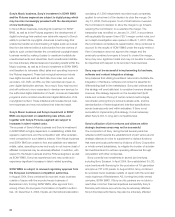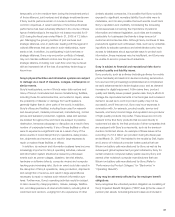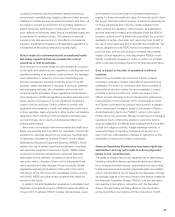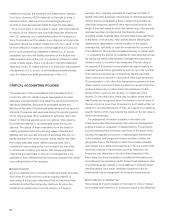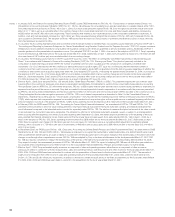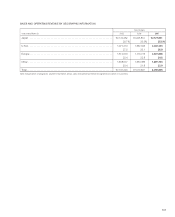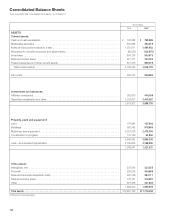Sony 2007 Annual Report Download - page 95
Download and view the complete annual report
Please find page 95 of the 2007 Sony annual report below. You can navigate through the pages in the report by either clicking on the pages listed below, or by using the keyword search tool below to find specific information within the annual report.92
often involves the use of significant estimates and assumptions.
Similarly, estimates and assumptions are used in determining
the fair value of other intangible assets. These estimates and
assumptions could significantly impact whether or not an
impairment charge is recognized as well as the magnitude
of any such charge. In its impairment review, Sony performs
internal valuation analyses or utilizes third-party valuations
when management believes it to be appropriate, and considers
other market information that is publicly available. Estimates of
fair value are primarily determined using discounted cash flow
analysis. This approach uses significant estimates and assump-
tions including projected future cash flows, the timing of such
cash flows, discount rates reflecting the risk inherent in future
cash flows, perpetual growth rates, determination of appropriate
market comparables and the determination of whether a
premium or discount should be applied to comparables.
During the fiscal year ended March 31, 2007, Sony recorded
impairment losses of 5,620 million yen in reporting units in the
Electronics segment, of which 5,320 million yen was related to
the CRT TV business which was downsized in the U.S., and an
impairment loss of 237 million yen in a reporting unit included in
All Other. These impairment charges reflected the overall decline
in the fair value of the subsidiaries. The fair value of the subsid-
iaries was estimated principally using the expected present
value of future cash flows.
Management believes that the estimates of future cash flows
and fair value are reasonable; however, changes in estimates
resulting in lower future cash flows and fair value due to unfore-
seen changes in business assumptions could negatively affect
the valuations, which may result in Sony recognizing impairment
charges for goodwill and other intangible assets in the future. In
order to evaluate the sensitivity of the fair value calculations on
the impairment analysis, Sony applied a hypothetical 10 percent
decrease to the fair value of each reporting unit. As of March 31,
2007, a hypothetical 10 percent decrease to the fair value of
each reporting unit would not have resulted in a material
impairment loss.
■PENSION BENEFITS COSTS
Employee pension benefit costs and obligations are dependent
on certain assumptions including discount rates, retirement
rates and mortality rates, which are based upon current statisti-
cal data, as well as expected long-term rates of return on plan
assets and other factors. Specifically, the discount rate and
expected long-term rate of return on assets are two critical
assumptions in the determination of periodic pension costs and
pension liabilities. Assumptions are evaluated at least annually,
or at the time when events occur or circumstances change and
these events or changes could have a significant effect on these
critical assumptions. In accordance with U.S. GAAP, actual
results that differ from the assumptions are accumulated and
amortized over future periods. Therefore, actual results generally
affect recognized costs and the recorded obligations for
pensions in future periods. While management believes that the
assumptions used are appropriate, differences in actual experi-
ence or changes in assumptions may affect Sony’s pension
obligations and future costs.
Sony’s principal pension plans are its Japanese pension plans.
Foreign pension plans are not significant, individually, to total
plan assets and pension obligations.
To determine the benefit obligation of the Japanese pension
plans, Sony used a discount rate of 2.3 percent for its Japanese
pension plans as of March 31, 2007. The discount rate was
determined by using currently available information about rates
of return on high-quality fixed-income investments available and
expected to be available during the period to maturity of the
pension benefit obligation in consideration of amounts and
timing of cash outflows for expected benefit payments. Such
available information about rates of returns is collected from
Bloomberg and credit rating agencies. The 2.3 percent discount
rate represents a 10 basis point increase from the 2.2 percent
discount rate used for the fiscal year ended March 31, 2006 and
reflects current market interest rate conditions. For Japanese
pension plans, a 10 basis point increase in the discount rate
would decrease pension costs by approximately 0.8 billion yen
for the fiscal year ending March 31, 2008.
To determine the expected long-term rate of return on
pension plan assets, Sony considers the current and expected
asset allocations, as well as historical and expected long-term
rates of return on various categories of plan assets. For Japanese
pension plans, the expected long-term rate of return on pension
plan assets was 3.5 percent and 3.7 percent as of March 31,
2006 and 2007, respectively. The actual gain on pension plan
assets for the fiscal year ended March 31, 2007 was 0.8
percent. Actual results that differ from the expected return on
plan assets are accumulated and amortized as a component of
pension costs over the average future service period, thereby
reducing the year-to-year volatility in pension costs. As of
March 31, 2006 Sony had unrecognized actuarial losses of
169.9 billion yen and as of March 31, 2007 Sony had a net
actuarial loss of 200.6 billion yen, including losses related to
plan assets. For the fiscal year ended March 31, 2007, the net
actuarial loss increased due to the difference between the actual
rate of return on pension plan assets and the expected long-
term rate of return on pension plan assets. The net actuarial loss
reflects the overall unfavorable return on investment over the






